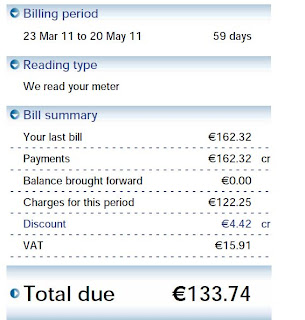The 5 zones are
Zone 1 - Utility Room (230V 270W 15m 18W/m 196 ohm)
Zone 2 - Master en-suite (230V 270W 15m 18W/m 196 ohm)
Zone 3 - Main bathroom (230V 270W 15m 18W/m 196 ohm)
Zone 4 - Rest of house (230V 2295W 130m 18W/m 23.1 ohm)
Zone 5 - Office (230V 270W 15m 18W/m 196 ohm)
From March - October we did not need heating of any kind (including underfloor and hot water). The house was entirely heated by passive gain, heat recovery and by our own activities in the house (cooking, showering, appliances, lighting etc.)
In late autumn as the outside temperatures started to drop and we had fewer sunny days we switched on heating in Zones 1,2,3,5 (total 1 kW - cost €0.77 for 8 hours) from 0:00 - 08:00 to avail of night saver electricty. As this is underfloor heating the heat continues to disapate into the rooms for several hours after heating switches off.
During winter when the weather forecast is for freezing we include Zone 4 (with zones 1,2,3,5 gives a total of 3.3 kW - cost €2.56 for 8 hours) in our night rate heating. So far this winter I would estimate we have had Zone 4 heating enabled for 10-15 nights.
To boost the heat in specific rooms we using a Dimplex 3kW Eco Cadiz Oil Free Radiator (CDE3ECC Model). Check out the positive review on Argos web site at http://reviews.argos.co.uk/1493-en_gb/4150994/reviews.htm. Features from the Dimplex Web Site
The Cadiz Eco is packed with energy-saving features. All models feature dual heat panel technology, which gives the option to switch on just one side of the heater – ideal when positioned against a wall, as it avoids wasting energy on heating the wall. As controllability is the key to keeping fuel costs down, the 2kW models have an electronic 24 hour timer, while the 2kW and 3kW top of the range models feature full climate control and a highly accurate electronic thermostat, as well as a remote control handset.We use this to boost heat in the children bedrooms to 23-24 degree after they have a bath. We also use it in our living room if needed when we sit down to watch TV after the kids have gone to bed. It takes approx 30 mins to heat our room from 17 to 21 degrees. Once at this temperature the unit will kick in and out very infrequently to maintain the temperature. We find we only need this on those horrible days were it is dull, overcast and wet. We had a couple of weeks of this weather in November. The one thing that all passive house owners want to see is sun. Even 1-2 hours per day in the middle of winter can make a huge difference to the temperature inside the house. No matter how cold it is outside a couple of hours of sun will heat our hot tank and boost the internal temperature in our south facing living areas to 22-23 degrees and this temperature will dissipate very slows when the sun disappears.
Using the Eco Cadiz it will start with 3kW if the room temp is more that 3 degrees less that the temp set on the radiator. e.g. suppose it is 18 in the room and we set he thermostat to 21 then it will start with 3Kw and at 20 degrees switch to 1.5kW. It will then switch off when temp hits 21. Once the temp drops to 20 it will switch on again at 1.5 kW. Running this for 1 hour at 3kW cost €0.60. 1 hour at 1.5 kW cost €0.30 (using day rate rather than night rate which applies before 11pm during winter).
One thing that most people who enter the house during winter find very unusual in our house is that we can keep all our internal doors open, even those opening into our hallway and the house is a consistent temperature. Most people are used to having a fire/radiator on in a living room and having to keep the door closed so as not to loose heat. This is not necessary in an air-tight house. There are no cold spots.
I should also not forget to mention the very important function of our Heat Recovery unit which is constantly boosting the supply air temperature into our living and bedrooms.
We have prep'ed our attic for the installation of a flu for a solid fuel stove in our living room. However after getting this far into winter with minimum heating I dont think we will feel we need one.
Here are two of the of the most satisfying aspects of owning a passive house;
- No running out to the shed in the rain to get coal for the fire and the resultant loss of heat in leaving and re-entering the house. Some Passive House owners will opt for a solid fuel stove but I would assume that very small amounts of fuel would be required.
- Never having to call the Oil company for a delivery or having to mess with dirty bags of coal/briquettes.







